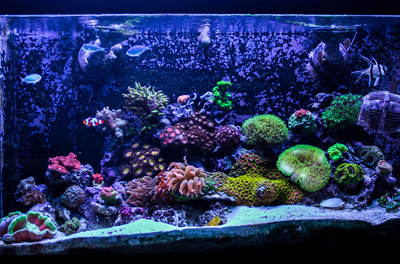There’s an oft-repeated adage in this hobby that you can take to the bank: “Only bad things happen quickly in marine aquariums” (or some variation upon that general theme). In other words, while problems in marine aquariums seem to crop up overnight, effectively solving said problems tends to be a frustratingly long, drawn-out affair. Getting overeager to see results and jumping from one “quick fix” to the next is counterproductive at best.
One of the more obvious examples of this phenomenon can be seen when impatient hobbyists use medication to treat a sick fish. In this situation, the counterproductive behavior (on the hobbyist’s part) can take one of two forms: either assuming a fish is cured and stopping treatment prematurely because the symptoms seem to have abated, or repeatedly switching from one medication to the next because the symptoms don’t seem to be resolving quickly enough.
In the former scenario, it’s virtually assured that the disease symptoms will reappear, potentially after the fish has been introduced or reintroduced to a stocked system, which means the other fish will then have been exposed. Remember, it’s critical to follow medication dosing instructions to the letter and to complete the full course of treatment. In some cases, repeated courses may be necessary to effect a complete cure. You can’t rush it.
In the latter scenario, the cure is, for all intents and purposes, worse than the disease. Not only is the fish subjected to a highly stressful barrage of different medications, but no one medication is given adequate time to do its job, so the disease will likely persist if the fish manages to survive the ordeal.
Issues with coral placement in reef systems also take time and an incremental approach to resolve. Corals and other sessile invertebrates typically show their dissatisfaction with a particular location by remaining in a contracted state—i.e. with their tissues/polyps withdrawn. Of course, some will also do this for a time right after being introduced to a new system, even if conditions are favorable, and some, such as the various leather corals, will occasionally close up, shed a layer of tissue, and reopen as a natural regenerative process, so you can’t necessarily assume there’s a problem with placement based on this behavior alone.
Assuming you can rule out these exceptions—along with stinging by a neighboring invertebrate, nipping by a fish, or other direct tankmate aggression—you’ll need to evaluate and possibly make adjustments to factors such as light intensity and water current. Start with the most likely variable based on what you know about the particular species’ needs and make an adjustment to that variable only.
For example, if you suspect the specimen is getting too much current, either redirect/turn down the water flow that reaches it or move the specimen to a lower-current area, if possible without changing the light exposure it receives significantly. Or, if you suspect the light is overly intense or inadequate, either adjust the output of the light fixture or move the specimen up or down the rock structure accordingly, in this case keeping the water current as close to the same as possible.
This isn’t an exact science, because changing light or current levels in isolation is easier said than done, especially if it’s necessary to move the specimen rather than adjust the output of lights or pumps. The basic idea is to isolate and make a modest adjustment to one variable (to the extent possible) and then wait to see how the specimen responds to the change before making another incremental change to the same variable or changing your focus to a different variable. Taking a shotgun approach—constantly tinkering with every variable you can think of—will simply delay the outcome you’re seeking because the specimen will essentially be in a constant state of re-acclimation.
Of course, these are just a few of many possible examples of how rushing remedies in the marine aquarium hobby can be counterproductive. Fellow salties, we’d love to hear from you on this topic, so feel free to share more examples in the comment section below.



